Recent news and commentary articles about photographic, video, mobile, and gadget gear:
- Smartphones Become Compact Cameras
- The High-End New Compact Standard
- Fujifilm Updates the X Series Cameras
- Apple Ups the Smartphone Ante
- 1” Is the New Bottom
- How to Churn Correctly: Sony RX-100III
- Lytro Goes Pro
- Binocular Vision
- Cameras Don’t Stand Alone
- How Smartphones Will Continue to Kill Cameras
Smartphones Become Compact Cameras
Two introductions during Photokina showed that smartphones aren’t done gobbling up the low-end compact camera market. Both, curiously, use large sensors.
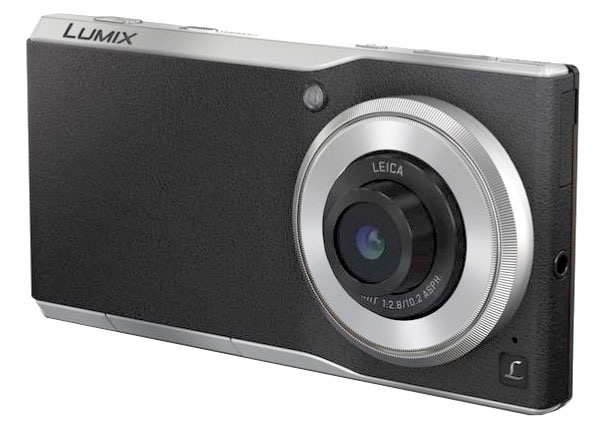
First up is Panasonic’s CM1 smartphone, which pairs a 20mp 1” sensor with a Leica 28mm (equivalent) f/2.8 lens behind a mechanical shutter. The sensor is about seven times the size of most smartphone sensors; a 20mp 1” would be about 2.5 microns compared to the iPhone 6 at 1.5 microns, so the iPhone probably has about one third the light gathering and less than half the photosites as the CM1.
Compared to Apple’s iPhone 6, the CM1 is also three times thicker. But otherwise, it is the usual smartphone pocket size, sporting a 4.7” 1080P display. As you might guess, there’s a dedicated shutter release, but things that are less evident are the ability to adjust focus, aperture, shutter speed, ISO, and white balance manually (the first via a dedicated focus ring, the rest via the camera app). You can shoot raw files with the CM1 as well as 4K video. Also included is a microSD card slot, as the included 16GB memory probably isn’t enough for someone who’d really want to use this as a camera. Inside, the CM1 runs Android.
Panasonic isn’t all in on the idea of the CM1, though. It will be available only in France and Germany later this year at 900 Euro as a test to see whether to pursue the product further.

Meanwhile, we have Relonch, which is an APS camera shell your iPhone 5 or iPhone 6 slides into. This is akin to the Sony QX model, where you “add a dedicated camera” to a smartphone, but it appears that the control mechanism is via the Lightning port, not via WiFi, which should make things a bit different. If nothing else, there’s no pairing necessary to establish the connection.
Inside the “camera” is an APS-sized sensor in front of an unspecified “normal” lens (though the images all seem to be 1:1 aspect ratio for some reason). Shown in prototype form at Photokina, this unit is said to be available “late 2015” for US$499 (orders being taken). Many of you will recognize this is as a large form of an idea I presented years ago (with the 30-pin connector on the previous iPhones). It’s an approach I expect Apple to take some day, as well.
The High-End New Compact Standard
It seems that Sony started something with the RX100: use a 1” sensor with a fast mid-range collapsing zoom and put it into a body that is shirt-pocketable. Of course, Sony is on their Mark III version of that design (quite a good camera, by the way). But that isn’t stopping others from joining in.
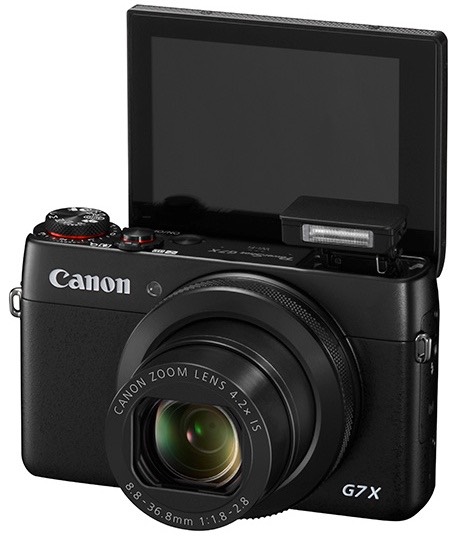
Canon today announced the G7 X, probably the most confusing name they could have chosen. Haven’t we already had a G X and a G7? Maybe they think 7 is lucky, or maybe that’s the only number they had left in their mold etchings that wasn’t worn out, I don’t know. Moreover, this camera seems to be the update to the S90/100 series, so where did the S go?
What we get in the US$700 G7 X is the Sony 20mp 1” sensor coupled with a 24-100mm (equivalent) f/1.8-2.8 lens, a 1m dot touchscreen, a built in ND filter, 1080P/60 video and some other PowerShot stuff. As you can see from the photo, it even has a “selfie” mode. What, no EVF, no hot shoe? Oops. Basically we have a Sony RX100II without the EVF option but with a slightly longer telephoto reach. Or a Canon S100 with a 1” sensor.
So that brings me to an aside. When markets begin collapsing and the clear market leader stops innovating and begins copying, the end is nigh. This isn’t good for anyone. The innovator here—Sony—has a tougher time dislodging the leader because the leader has something that’s “close enough” and the leader still tends to have pricing advantage. The copier tends to send a message to everyone that there’s nothing new to look at in the market any more, so you should buy on price only. What happens next is Darwinian survival at its most brutal, and the good genes don’t always win out over the bad.
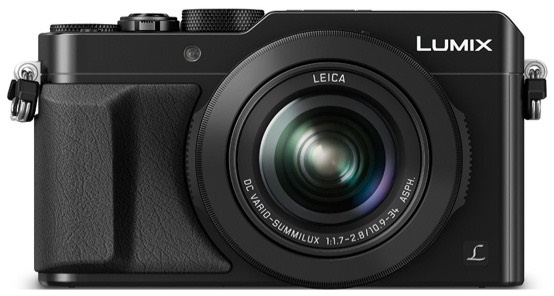
Which brings us to the US$900 Panasonic LX100. It uses a larger m4/3 multi-aspect sensor that produces 12mp in m4/3 and 3:2, has a 24-75mm f/1.7-2.8 collapsing lens, a hot shoe (for the included external flash), a built-in 2.8m dot EVF, WiFi, and can record 4K video at 30 fps or 1080P at 60. And yes, it can fit in a pocket, though not in a shirt pocket as it’s not quite as slender as a Sony RX100. At least Panasonic’s name makes a little more sense: “hey, it’s our version of an RX100 but with an L!”
Actually, that last is a little unfair. The LX100 is a bit of everything, including some design cues from Panasonic’s original Lumix 4:3 camera plus a few from the recent GX7 (including that camera’s EVF, though it doesn’t tilt). It also has a full set of retro controls (aperture ring, shutter dial, exposure control dial). Focus is via the DFD system found in the GH4 and FZ1000, which should give quick, sure focus.
As usual, Nikon is off pursuing other ventures at the moment, but they’ll eventually have a Coolpix that tries to shoehorn into this category.
So, in the large sensor compact territory these days we have essentially two camps. The rough breakdown is:
- The RX100 camp: pocket camera with fast mid-range zoom, preferably with an EVF (Canon, Panasonic, Sony)
- The X100 camp: bigger camera with APS size sensor and fixed prime lens (Fujifilm, Nikon, Ricoh, Sigma)
The RX100 camp is winning, and now has three very interesting choices in it. In the X100 camp, Fujifilm is winning as Fujifilm just iterates the heck out of their entry while the others sit pat.
As for what to pick, I’m with dpreview on this one: the Sony RX100III produces really nice shots, but it’s a bit of a pain to shoot with. The more traditional and photographer-oriented controls of the Panasonic LX100 and Fujifilm X100T are more appealing, I think. So the choice is a little more complex than it at first seems. I think it all boils down to how you’ll carry and shoot with the camera. If it really has to go in the shirt pocket and still shoot with an EVF, the Sony RX100III is the clear choice. If you can tolerate something bigger or the lack of an EVF, the choices just got much more interesting.
Support this site by purchasing from this advertiser:
Fujifilm Updates the X Series Cameras
Late last month Fujifilm announced the X30 camera, the latest in the X## series of cameras. Today Fujifilm announced the X100T, the latest in the X100 series.

The X100T is the third in the series of cameras, each of which has had major improvements over the previous. In the case of the T version, the big improvements are in the displays. The EVF adds a new electronic tab that can appear in the optical viewfinder view, allowing a digital split image view as well as the optical view. The control lever on the front of the camera that controls the hybrid EVF now has an extra position to enable that tab. In addition, the EVF itself now has the fast near 60 fps refresh that first appeared on the XT-1’s EVF. Parallax adjustment has improved, as well, meaning less focus-and-recompose situations at close distances.
Meanwhile, the rear LCD has gone from 2.8” 460k dot to 3” and 1.04m dot. Other changes to the camera include an electronic shutter mode that goes to 1/32000 second, third stop settings on the aperture ring, and more range on the exposure compensation control (now +/-3 stops). An additional customizable button has been added to the back, and the control layout more closely resembles that of the X mirrorless cameras now. Indeed, the changes made to the X-T1 Graphite Silver model all seem to be present in the X100T, as well, including the addition of a Classic Chrome film simulation, the customizable Q button, and spot metering following the focus point.
Other aspects of the US$1299 X100T are basically the same as the X100S: 16mp APS X-Trans sensor, 23mm f/2 fixed lens, built-in flash, and built-in wireless. The X100T uses the same NP-95 battery (good for 330 shots CIPA), which is a good/bad news thing; many users were hoping for a larger battery capacity on the updated model. The whole package comes in at about a pound (440g), and at a size that’s bigger than shirt-pocketable.
Overall, the X100T is a nice update that will keep the camera current for the time being. Personally, I think the sensor is a slight weak point in an otherwise fine camera. I’d really like to see the Sony 24mp APS sensor in such a package.
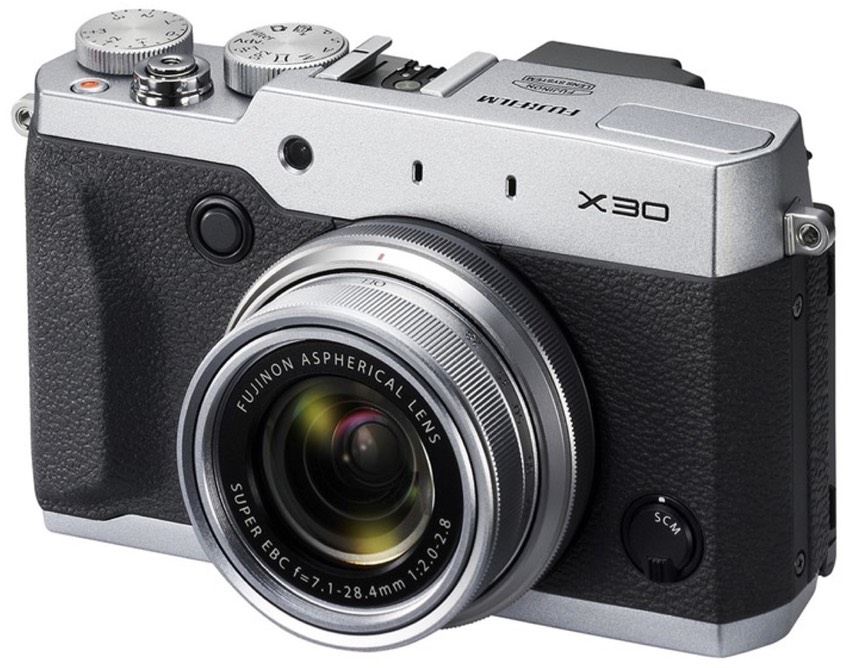
Meanwhile, the X30 is the third in Fujifilm's series of small-sensor compacts (12mp 2/3” X-Trans sensor). The big changes are similar to those in the X100T over its predecessor: new viewfinder (now fast EVF instead of optical), larger and better rear LCD (3” 920k dot) that tilts, Classic Chrome simulation. We also get a control ring around the lens and WiFi that weren't on the X20. What remains the same is the 28-112mm (equivalent) f/2-2.8 lens, built-in flash, and basic body design. The NP-95 battery is now good for 470 shots CIPA, which is a big improvement over the X20.
The big improvement in the X30 has to be the EVF, though. Not only do you get an accurate view, but an impressively big and usable one. That said, I think that’s a bit wasted on the 12mp 2/3” X-Trans sensor. Unlike the 16mp APS version of the sensor, I find the smaller version has clear deficiencies when it comes to outputting at maximum size, especially in low light conditions. Still, it’s nice to see a camera company not completely abandon an old design for a new design, but instead try to refine it. The X40 is going to need a better sensor, IMHO, for this product to remain compelling. That said, at the US$599 price, the X30 delivers a lot. Just don’t expect it to be competitive at large print sizes and especially in very low light.
Support this site by purchasing from this advertiser:
Apple Ups the Smartphone Ante
Apple’s new iPhone 6 and 6 Plus, announced today, push even further into the compact camera arena. In particular, the new phones now have phase detect autofocus on the imaging sensor, much like many of the mirrorless cameras have been using lately. Apple claims twice the focus performance as before, and the iPhone wasn’t exactly slow to focus before due to the use of a small sensor and a wide lens.
Other aspects of the iPhone 6 and 6 Plus camera that push the envelope into compact camera realm further (or beyond) are:
- 43mp Panorama stitching mode, coupled with gyroscopic data captured during the swivel to make for better stitching.
- Image stabilization is built into the processor of the iPhone 6 Plus, essentially trading off a few pixels for better image data.
- Video now records at 30 and 60 in full 1080HD, plus 240 fps in 720P, plus a time lapse function is also available. Autofocus is continuous in video recording.
- Single-shot HDR is now available, using the multiple read system they patented in 2012. Basically the camera reads the sensor data once after a short period (highlight exposure), doesn’t reset the data and then reads it again after a long period (shadow exposure).
- If you have an Apple Watch, you can use it as a viewfinder to what the iPhone camera is seeing.
While only 8mp (the front-facing camera is 5mp), Apple made a number of changes to both the image sensor and lens used to improve the performance of the imaging. For example, the photosites are now 1.5 microns square, larger than in the iPhone 5. I don’t think it is random that Apple has stuck with 8mp in the iPhone camera, by the way: that’s essentially what you need to fill a 4K video screen size. You can certainly find more pixels in smartphones, but you’d be displaying those images downsized in almost any output you’d consider other than print.
1” Is the New Bottom
(news & commentary)
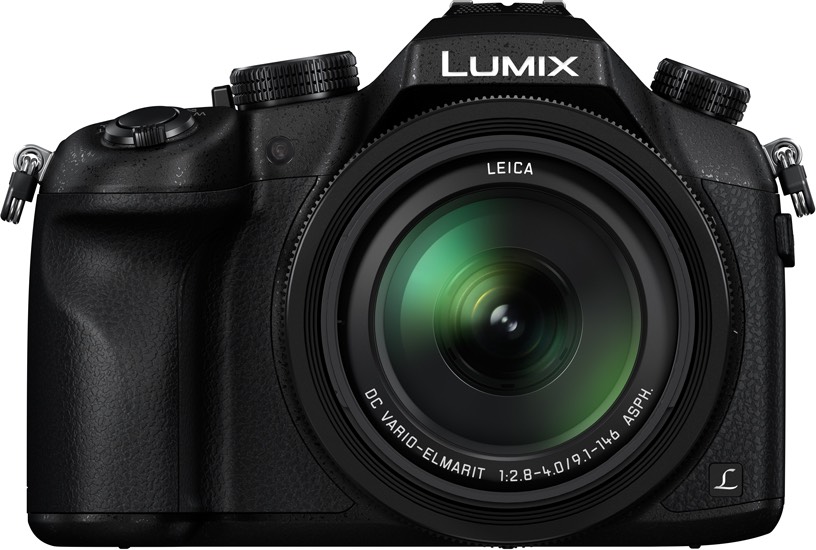
Panasonic today announced the FZ-1000, their response to the Sony RX-10. 1” 20mp sensor? Check. 4K video? Check (30fps at 100Mbps bit rate). Lots of lens? Check (25-400mm equivalent f/2.8-4). At US$900 it’s far less pricey than the Sony, which is surprising given Sony’s recent aggressive pricing moves.
Other things you might want to know about the FZ-1000 are that it uses a DSLR-type styling, has 5-axis lens stabilization, gets the popular 2.4m dot OLED EVF used in the high-end cameras, can shoot 1080P at 60 fps (though only at 28Mbps bit rate), and features some of Panasonic’s recent optical advances. That last bit is courtesy of the Leica Vario-Elmarit lens that uses Panasonic’s new aspherical lens production technique, which removes the onion-effect on out of focus highlights, plus the use of Panasonic’s DFD autofocus system, which uses the characteristics of the out-of-focus regions to predict where focus should be.
Of course, all of this turns out to be DSLR-like in another way: 1 pound, 13 ounces (831g), and a size that’s not close to pocketable. In many ways, the FZ-1000 is after that “everything but the kitchen sink” spot that Sony tried to hit with the RX-10. The “kitchen sink” in this context is interchangeable lenses.
A lot of folk got excited by the Sony’s 24-200mm (equivalent) f/2.8 lens. But realistically, once you factor in the sensor size, that’s really much like having a DX (APS) camera with an f/5.6 lens. (Note to Nikon: 18mm DX is not nearly wide enough for all those super zoom lenses you’ve been creating; they should be 16-xx mm). So what are you gaining from the all-in-one approach? Not much, really. In some ways, you’re losing (pixel count, battery life, price compared to DSLR, etc.). Thus, it’s the things like 4K video that’ll get played up in the ads, I think.
Still, Sony just got some wind taken out of their sails (I almost wrote sales ;~). This is much like the Nikon Coolpix A followed by the Ricoh GR: bigger company prices too high, hungrier company comes at them with a similar product at a much lower price. So, if you were interested in the RX-10, you have to now take a long look at the Panasonic FZ-1000.
But the big thing here is 1”. We’re getting more and more camera makers using 1” in their systems: Nikon, Panasonic, Samsung, and Sony are already there, with more cameras and companies about to join in. Most are using the Sony Exmor BSI 20mp sensor, but there are other sensor variations around, including the 10, 14, and 18mp Aptina ones that Nikon has used. By the time Photokina is over, we could have a majority of camera companies offering some form of 1” sensor product.
This, of course, makes for an interesting problem (opportunity) for Nikon. While they were ridiculed for using a 1” sensor when they introduced the Nikon 1 series a few years ago, that wasn’t their problem, in my opinion. They were simply ahead of the game. The problem was the product design and price, neither of which actually matched up well with the likely market for such products.
Which brings me back to one of the topics I’ve been writing about for many years now: the squeeze. Let’s face it, pro DSLRs are pretty much the top of what the market is going to buy in any manageable quantity for the camera companies. The US$5000 price point is one that is dangerous to cross, as elasticity of demand plummets beyond that (and it’s already low by the time we get there). Meanwhile, the march of the smartphones has pushed the floor considerably upward, almost eradicating the under US$500 camera market. Meanwhile, the US$500-1000 range was the meat and potatoes range of the DSLR makers (and still is).
Frankly, we haven’t seen the end of this. 1” is the current new bottom of the camera sensor market (it used to be 1/2.3”). But it’s competing with larger m4/3 and DX (APS) sensors in the same price points now. The Nikon 1 is actually starting to look more interesting, because when you equip a 1” sensor like a DSLR as Sony and now Panasonic have, you get a far bigger camera than the still small Nikon 1’s, and you lost the interchangeable lens.I can already get the 1” all-in-one type of camera cheaper and with a better sensor from Canon and Nikon in their DSLR lineups. So we’re going to see the next step being even larger sensors in these all-in-one cameras, I think.
The bottom line is this: there isn’t a lot of room to differentiate now when all is said and done. In the US$500-1000 market we currently have high end compacts, all-in-one compacts, mirrorless, and DSLRs. Something tells me the DSLR makers aren’t going to sit still. Well, they shouldn’t sit still, though they kind of appear to be doing so at the moment.
What’s the proper response if you’re Canon and Nikon? US$500 DSLRs that match the performance and feature sets of all these upstarts. But here’s the kicker that Canon and Nikon haven’t seemed to understand: more crop sensor lens choice. The whole thing about interchangeable lens cameras is that, well, the lens is interchangeable. Making 18-infinity zooms effectively renders an interchangeable lens camera as a fixed lens camera. You have to deliver convenience and flexibility. Right now we mostly see the DSLR makers targeting convenience. Well, if you don’t remove the lens from the camera ever, then the all-in-one cameras are just as good as your DSLR, aren’t they? ;~)
I really hate to sound like a broken record, but I just totally fail to see how Canon and Nikon missed this: make more crop sensor lenses so that the full range of options are available to your DSLR users. That’s the only way you defend the DSLR.
Meanwhile, I’m scratching my head a bit with Panasonic, too. It seems clear that the G6 type of camera is not going to be extended, though it was popular with owners. The GM1 (shirt pocket) and GH4 (DSLR with video) are the standard bearers of their m4/3 lineup now. But why not just stick the m4/3 sensor into the FZ? The answer basically boils down to lens: to get to the marketing number of 400 (mm), you need to use a smaller sensor or else you’re going to have a big camera. Yet imagine if the FZ had the m4/3 sensor and a 12-100mm f/2.8 lens (24-200mm equivalent). Trumps the RX-10 with a bigger sensor.
Which brings me to why people are using the 1” sensor: price. Sensors are generally the most expensive component in a digital camera. Sensor price scales somewhat exponentially with area. So 1/2.3” sensors these days are cheap, 1” sensors more expensive, m4/3 sensors even more expensive, and so on right up to medium format sensors, which are hugely expensive. (Ironically, this was true of film, too: the cost per shot went up with the capture area. The only difference was that this was a variable user cost, not a camera cost. Thus, a medium format body could be made as cheaply as a 35mm camera body, and some volume 35mm users were paying more for film and processing a year than medium format users.)
Note: in PAL countries you get 25 and 50 fps, not 30 and 60 fps.
Support this site by ordering from this advertiser: B&H
How to Churn Correctly: Sony RX-100III
(news & commentary)
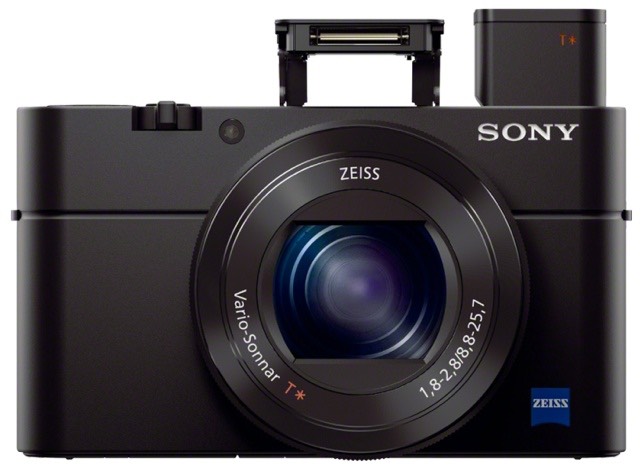
Sony today introduced the third iteration of their popular RX-100 compact camera. What’s new? Three things, primarily: the lens now is f/2.8 instead of f/4.9 at the telephoto end (the wide end remains f/1.8), the lens itself is now a Zeiss-designed 24-70mm equivalent (the old one was 28-105mm), and the camera now has a pop-up 1.4m dot, 0.59x magnification EVF built-in.
Other key features most photographers considering this camera might be interested in: up to 10 fps continuous burst; 10-12 frame buffer depending upon image quality setting; 1/2000 top shutter speed plus a built-in 3-step ND filter; ISO 125-12800, extendable a bit at each end; WiFi with NFC support to iOS/Android apps; and NP-BX1 battery rated at 320 images CIPA. The focus system is still contrast-detect based and the image sensor is still the 1” 20mp one used in the the RX-100II. Weight with card and battery is about 10 ounces (290g). Video recording has switched to XAVC-S (50Mbps bit rate) instead of AVCHD, a welcome change, though not supported by all video workflows yet. Clean HDMI is available to record externally. The camera has grown a tiny bit in size and weight, too, though not enough to factor into decisions. The new camera will ship in mid-June.
The original RX-100 resonated with many users, including myself, for being a highly competent shirt-pocket compact camera. The 20mp 1” sensor was bigger and better than that of any other shirt-pocket contender, the lens was good, the features and UI decent. Sony upped the ante with the second model by adding BSI (back side illumination) to the sensor, giving it a modest boost in capability, and adding the ability to add an optional EVF via the hot shoe, two welcome additions, and enough that I sold my RX-100 and bought an RX-100II (I already had the EVF from another Sony camera I was using).
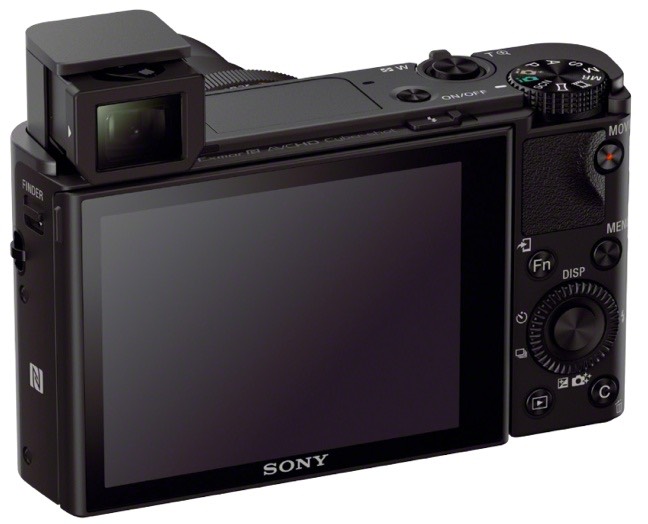
Now Sony has upped the performance game just a bit more by giving us a more “pro” mid-range zoom in the camera (24-70mm equivalent f/1.8-2.8) and getting rid of the “optional” on the EVF. Someone at Sony is understanding the RX-100 user just about right: these quick iterations are example of product churn done correctly: improve performance significantly or add the most requested feature. In the case of both iterations so far, Sony did both. Better still, Sony has snuck in a few other minor changes that make it a better, more usable camera for serious users, such as the user-controlled ND filter.
The tricky problem is keeping price creep out of the picture when you do this. The camera will sell for US$800, which is indeed a small price creep. (Updated: apparently Sony changed the US price from what I was originally told.) Right now you can buy the original model for US$550, the second generation for US$700. Effectively you’re getting the EVF and the other changes for US$200, but still, that’s enough of a change to slow some from jumping on it. For those of us who have the previous model and the optional EVF, it becomes a question of just how much we want that new lens.
The change in lens is going to give some of us a bit of pause, though. I like the stretch to 24mm, I don’t like the loss of 100mm, though getting f/2.8 at 70mm is nice. 85mm would have been a more useful long end, but thing is, f/2.8 for the telephoto end of a lens starts to push size up fairly rapidly as you add focal length. I can see how Sony got to their decision: keep the camera basically the same size and improve the lens. That puts limits on what you can and can’t do, and f/2.8 at 100mm was too big a size change to fit in. Thus, what’s the next best choice? Good question, and Sony’s choice is arguably a defensible one. Still, it gives me just a little bit of pause. (Disclosure: I’m not a big mid-range fan. When I use my 24-70mm lens on my FX DSLR, I tend to use it only at 24mm or 70mm, thus to me the new Sony is a bit like having two primes.)
Why am I stuck on the lens question? Because of the Panasonic GM1, that’s why. Yes, the GM1 with lens is larger than the RX-100, but not enough so to change the way I use such cameras. If I were purely “needs to be shirt-pocketable,” then yes, the RX-100 still would clearly be my choice. But I tend to use my “small” camera as a jacket-pocketable camera, so I’ve got a bit more room in that pocket for something bigger in the lens area. The GM1 offers a larger, better performing sensor, and less need to keep diffraction in account. It also lets me also pocket a small prime or two for some serious shooting. Still, all-in-one versus bigger-but-more-flexible is a tough choice. Moreover, I lose the EVF. I can see people going either way.
Still, the point I want to make here is that, at least with the RX-100, Sony is doing exactly the right thing: when you have a camera that’s a “winner” and resonating with a group of users, quickly iterate it with the most user-requested needs. Not ditzy features like a new Art Filter or 55 more menu commands that let you tailor obscure settings you don’t understand in the first place. No: iterate the photographically useful things. EVF, check. Better lens, check. ND filters, check. Along the way, try to push performance and image quality upwards (also check in the I to II iteration). Don’t keep changing the controls, the design, the battery, the accessories, etc. Keep the changes to ones that a functional for photographers.
Besides being the right thing for the customer, this kind of iteration makes it more difficult for a competitor to come knock you off. About the best they can do is catch up to you, which means that you should preserve your First Mover status in the market and sell better than they do. Imagine the Canon and Nikon teams examining the original RX100: oh, we can do better by offering an accessory EVF. Oops. Sony just did that. Maybe we can make a better lens. Oops. Sony just did that. In other words, the competitors have to target your next iteration, not your current one, which is a much tougher thing to do quickly and well.
So I applaud Sony for this third iteration of the RX-100. The original was a shirt pocket wonder, and now we’re two steps better than where we started without goofing up any of the things that were good.
Support this site by purchasing from this advertiser:
Lytro Goes Pro
(news & commentary)
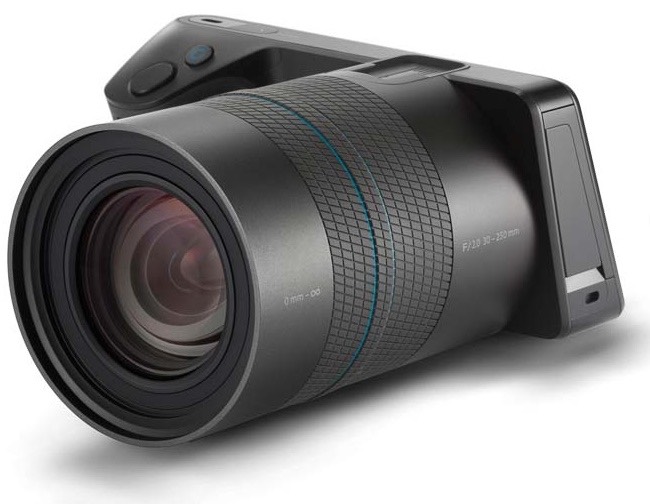
Lytro pre-anounced the Illum, a new light-field camera that will ship this summer. With a 30-250mm (equivalent) f/2 thirteen-element lens capable of 1:3 macro up front and a 1” 40 megaray sensor out back, the Illum hopes to help Lytro jump from curiosity to real use.
What kind of use would that be? Facebook, Twitter, Pinterest, and Google+ sharing is integrated into the software, which should tell you something of intent. That 40 megaray number needs to be divided by 16 or 32 for light-field work, meaning that the camera is likely either 1.25mp or 2.5mp in terms of actual photo size. The thing about the Illum that will prove useful to some is that focus speed isn’t an issue: focus is done after the fact, so there’s no wait for the camera to acquire focus. Also Lytro is promising perspective and tilt type adjustments, as well.
Lytro is also saying that the workflow for the Illum will be compatible with Photoshop, Lightroom, and Aperture, which seems to imply that they’ve developed plug-ins for their post processing capabilities.
In terms of the camera, not a lot is known other than it has a 4" articulating touchscreen, a hot shoe, a 1/4000 top shutter speed, and weighs 2 pounds, 1 ounce (940g). Curiously, Lytro says the lens only weighs half a pound, so that makes the camera a 1.5 pound beast, right? ;~) All for US$1595.
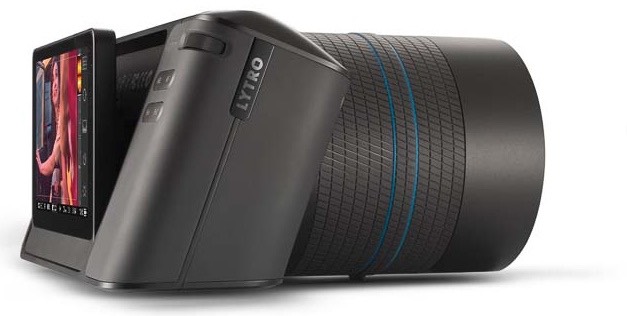
What is curious to me is why announce such a camera now? It seems premature, though it’s possible that Lytro is trying to pre-judge production needs. Still, we’re three months away from shipment on something that at the moment has to be judged solely on press release statements. The problem for Lytro is going to be trying to keep the hype up for three months and then hoping that the hype is exonerated with the actual product’s first reviews. Given the price, this is not a spontaneous decision kind of product, but one that most people will want to know much more about before committing.
You can pre-order the Illum at a discount to US$1495 with a US$250 deposit, which also nets you a few additional benefits (something the Japanese camera companies should take note of): limited edition engraving, premium customer support, free shipping, and entry into a contest that has a prize of an all-expenses paid trip to shoot with Lytro and a professional photographer. You can pre-order from the Lytro Web site today.
Update: I’m a little confused by Lytro’s various statements about the sensor. They say it’s a 4x improvement over the original Lytro, which seems to put it at the 1.25mp mark when all is said and done. To put that in perspective, 2.5mp is where we were at the start of the DSLR generation in 1999.
Binocular Vision
(commentary)
HTC introduced the HTC One (M8) this past week, and there’s been a lot of discussion about it’s camera, which is a lot different than other smartphone cameras. We’ll see more of this clever use of multiple sensors, as I’ve written before, but let’s discuss what HTC is doing and how it works today.

The M8 has two imaging sensors (dark circles in image at right). The primary one is 4mp and provides the image data for the photo. The secondary one is offset, 2.1mp, and is used only to provide additional data to the image data. What additional data would that be? A binocular type data set.
Imagine for a moment that only one of your eyes provided the image your brain sees. That’s actually closer to the truth that you might think, as we humans all tend to have a dominate eye. So your brain is processing the image data from that eye. The other eye is providing a second set of data that is offset from the first, and our brain is using that to create depth information. This is binocular vision.
And that’s what the M8 is doing: 4mp of image data supplemented with 2.1mp of offset data to create an offset data set that can then be used to calculate a map of depth relationships.
The problem I see with the M8 is that the number of pixels used is too small. Of course, if you increase the amount of pixel data you end up needing a lot more computing power, so the choices may have been simply to stay within reasonable bounds for the current processor in the smartphone.
So here’s what the M8 and its software does: it applies progressive blur to areas determined to be further from the focus point. The problem I see with the results I’ve seen so far is this: there’s little subtlety in the transition between zones, and not enough zones. Instead of the circle of confusion becoming slowly bigger at a consistent rate, it tends to jump up to the next level in ways that the eye detects, thus the results look a little false. Again, I suspect the problem is that they just don’t have enough pixels or data or computer horsepower to do more at the moment. This technique should improve as you add all those things.
Meanwhile, Apple apparently is using a binocular approach a different way: they’ve patented a two-sensor design that separate luminosity from color information. This would be as if you right eye had all rods and your left eye all cones. I suppose you could still create depth data from this, by converting color information to luminosity information, but it appears Apple’s main goal is to increase dynamic range while reducing color artifacts.
We’re going to see more and more of this multiple sensor approach coming to the smartphone realm.
Cameras Don’t Stand Alone
(commentary)
One thing that doesn’t get mentioned in the “smartphone is killing compact cameras” debate is the notion that technology sometimes allows emerging economies to leapfrog infrastructure hurdles.
Let me give an example. In Africa, for instance, cell phones took off in ways that were originally not expected. Why? Because it’s far cheaper putting up cell towers near people than it is to wire everything together. It’s highly common now in Africa for people to have no wired phone but to have a cell phone. I’ll come back to this in a moment, but the primary thing I want to point out is that sometimes new technologies are such enablers that existing products and technologies just get left in the dust.
Solar is another thing making an inroad in Africa. Again, it’s the same problem: do you invest in one big monolithic thing (power plant) and then try to wire it up to everyone? In a big city environment that might make sense, but more and more in the urban and rural environments of emerging markets I’m seeing solar appear.
Indeed, those aren’t the only two. Satellite TV was another of those infrastructure skipping things to be successful. Thus, where a decade ago I might visit a small remote place that didn’t have electricity, phone, or TV service, today I find a solar panel on the roof alongside a satellite dish, and an owner who has a cell phone. No wires needed from some central location. Enough power to deal with their limited demands (though you’d need battery technology, too, if you wanted to watch TV at night ;~).
So what’s this have to do with cameras?
Simple: smartphones did the same thing to digital cameras that cellular phones did to landlines. It’s a little tougher to see, but it’s there.
Let me ask you a question: where do you store you photos?
Most of you reading this probably said “on my computer.” What if you don’t have a computer, though? What if you can’t afford yet another high cost, high tech investment like a dedicated computer?
Studies show that most smartphone users keep a large percentage of their images on the phone. Some keep all their images on the phone. Many “move” images to where their connections are (Facebook, Google+, Flickr, Dropbox, Tumbler, etc.). If they do a lot of image taking (most don’t), they are usually managing it with something (e.g. iPhoto, and maybe even iPhoto on their phone or tablet). Both Apple and Google, the primary smartphone controllers these days, probably want those photos to reside in their cloud and be managed by their software long term.
Now ask yourself this: where do the Japanese camera companies fit into this? Right, they’re like a coal-fired power plant in the middle of the Congo.
Okay, let’s go another direction, video. Who has the necessary horsepower to collect, edit, and distribute video? Oh, computer owners. Does it make a lot of sense to push video in cameras sold to emerging countries? Not right now. Perhaps when smartphones have 1TB of storage in them, but even then it would be tight (one single video project I’m working on has taken up 6TB of storage). So when the Japanese camera makers say in interviews that Americans and Europeans seem more interested in video than, say, the Chinese market, guess what they’re really saying?
Indeed, I keep seeing camera executive after camera executive talking about China these days. It represents a big potential set of new users to them. Then when China’s overall market and GDP expanded in 2013, why are all the camera makers saying they’re disappointed in their sales there?
Could it be that it’s Africa with cell phones all over again? Yes, there are a huge number of Chinese, Indian, and Brazilian (add any emerging market you’d like) customers that will be taking more photos in the future. The question being answered by smartphones is the infrastructure and workflow that enables them to do that. If instead you required a computer at home and additional software and disk storage space galore, well, I don’t think market adoption will happen the way the camera makers think. I’ll bet that those photos in emerging markets will be cloud-stored and cloud-managed and Internet-displayed only. So what feature in current cameras allows them to do that quickly, conveniently, and without additional hassle? Heck, do they even need or want 12mp, let alone 16mp or 24mp? File sizes, when we start transporting them mostly via wireless means, start to become incredibly important.
The two companies best poised to deal with these issues are Apple and Samsung. Especially Apple, since it has more of the software and cloud tools necessary already in place.
Personally, if I ran a camera company I’d want my cameras to operate seamlessly with Apple and Samsung smartphones and tablets. Seamlessly, as in automatically recognized, connected, and cooperating. I’ve yet to find one camera whose smartphone app is reliable enough to not crash regularly, let alone do what I suggest needs to be done. And I need to be able to drive what the smartphone will do with my images from the camera. I can’t keep taking the smartphone out of my pocket and asking it to do things. If that’s the answer, then I simply want a better camera in the smartphone and my problems all go away. See the dilemma for camera makers now? ;~)
When I write about smartphones having disrupted cameras, it’s not just on a superficial level (taking of images) that this happened. It’s a fundamental disruption of workflow, from start to finish. Building better cameras won’t solve the camera makers' problems. They have to change their whole definition of how cameras fit into people’s lives.
How Smartphones Will Continue to Kill Cameras
(commentary)
I’ve been waiting for this one for awhile, and it seems that HTC may be the first one to try it.
Who said that you can only have one sensor or one lens in a smartphone?
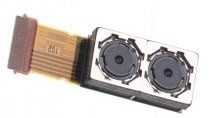
What if you coupled two sensors together and put different lenses on them? You’d end up with a number of very interesting options, as it turns out: you could have a slider that switches you from Sensor/LensA—say a 20mm equivalent prime—to Sensor/LensB—say a 50mm equivalent prime. Or, you could just leave them in place and have two lens openings on the back of the camera and let the user switch in software.
But here’s the kicker: if you have two sensors with different lenses simultaneously capturing information, you now have some interesting new abilities. Google, for instance, recently kicked off Project Tango, which uses a second sensor/lens to help do 3D mapping of the environment (note that I didn’t say 3D image, which is another possibility, but requires identical sensor/lens combos in a fixed relationship). But there’s more. An Israeli firm has demonstrated how to take two prime sensor/lenses and create a 5x zoom, which would make those smartphone cameras even more versatile. But you can also get HDR effects, faster focusing, and a host of other improvements by going the multiple-sensor route.
This is once again getting us to the way that smartphones hurt cameras in the first place: software.
Imaging sensors are ubiquitous and inexpensive. They’re just a building block part. It’s how you put those parts together and use them (software) that’s now the important thing. Because smartphones are selling in the billions and cameras are now selling well under the hundreds of millions, guess where all the action and money is going? Yep. Into smartphones.
Fast focus, HDR, high resolution, zooming, and virtually all the things that people have taken for granted in serious cameras lately are going to appear in smartphone cameras, and soon. Plus some things that current single sensor/lens cameras can’t do.
Look for nests of imaging sensors soon. It’ll start with 2, then move to 4. How far it goes from there is a bit unpredictable at this point, but what happens when you decide to use Bayer patterns with multiple small sensors (e.g. an all red sensor, two green sensors, and a blue sensor in groups of four)?


